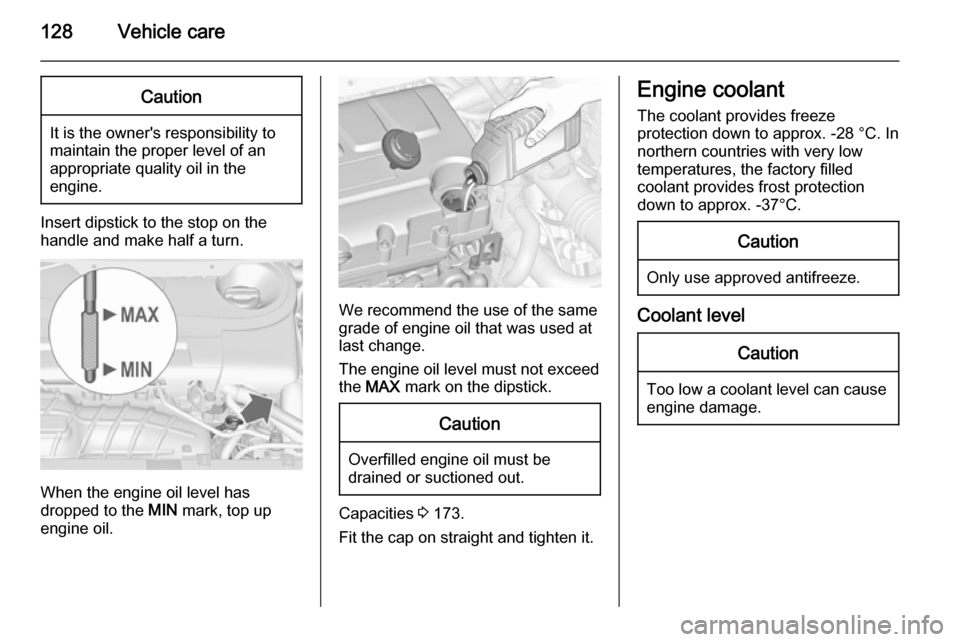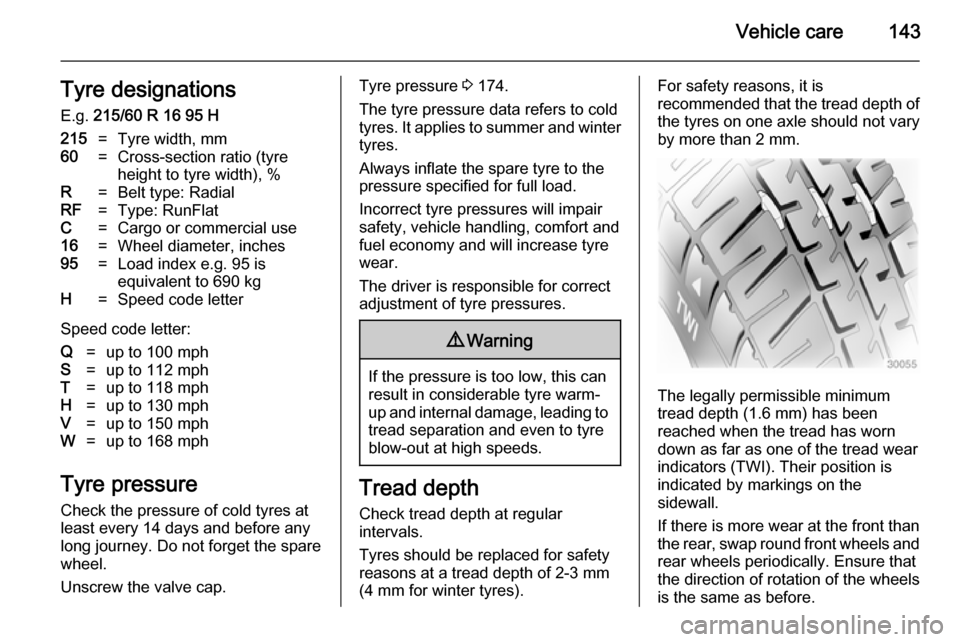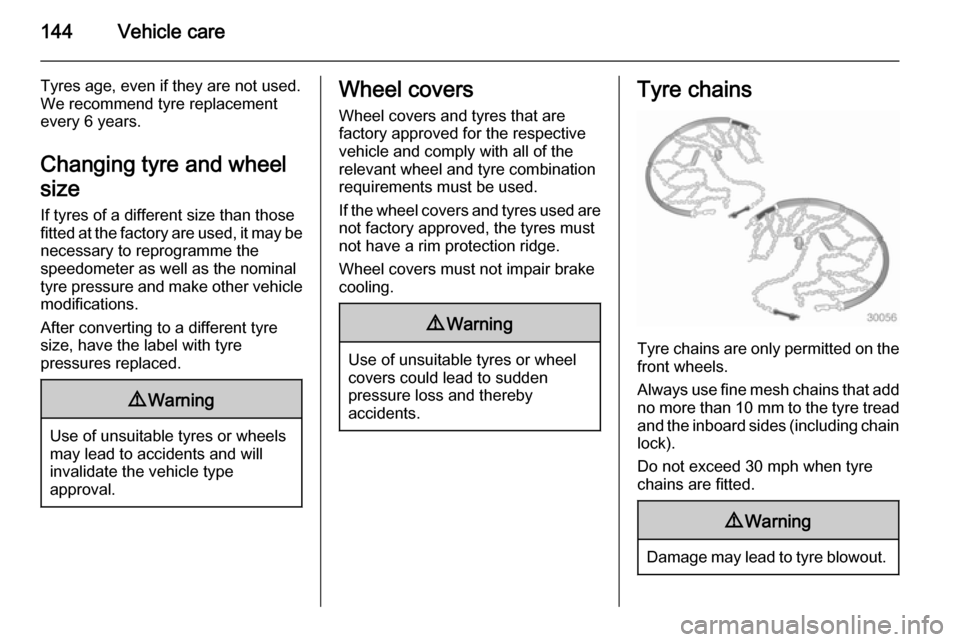ESP VAUXHALL COMBO 2014 Owner's Guide
[x] Cancel search | Manufacturer: VAUXHALL, Model Year: 2014, Model line: COMBO, Model: VAUXHALL COMBO 2014Pages: 187, PDF Size: 4.15 MB
Page 130 of 187

128Vehicle careCaution
It is the owner's responsibility to
maintain the proper level of an
appropriate quality oil in the
engine.
Insert dipstick to the stop on the
handle and make half a turn.
When the engine oil level has
dropped to the MIN mark, top up
engine oil.
We recommend the use of the same
grade of engine oil that was used at
last change.
The engine oil level must not exceed
the MAX mark on the dipstick.
Caution
Overfilled engine oil must be
drained or suctioned out.
Capacities 3 173.
Fit the cap on straight and tighten it.
Engine coolant
The coolant provides freeze
protection down to approx. -28 °C. In
northern countries with very low
temperatures, the factory filled
coolant provides frost protection
down to approx. -37°C.Caution
Only use approved antifreeze.
Coolant level
Caution
Too low a coolant level can cause engine damage.
Page 140 of 187

138Vehicle care
2.Prise the lamp assembly out at the
points illustrated.
3. Renew bulb, ensuring it engages correctly.
4. Reinstall lamp assembly.
Instrument panel
illumination Have bulbs replaced by a workshop.Electrical system
Fuses
Data on the replacement fuse must
match the data on the defective fuse.
There are two fuse boxes in the
vehicle:
■ on the right of the engine compartment, next to the battery
■ behind a cover on the lower part of the instrument panel, on the driver'sside
Before replacing a fuse, turn off the
respective switch and the ignition.
A blown fuse can be recognised by its
melted wire. Do not replace the fuse
until the cause of the fault has been
remedied.
Some functions are protected by
several fuses.
Fuses may also be inserted without existence of a function.
Fuse extractor
Use a fuse extractor to remove fuses.
Page 145 of 187

Vehicle care143Tyre designationsE.g. 215/60 R 16 95 H215=Tyre width, mm60=Cross-section ratio (tyre
height to tyre width), %R=Belt type: RadialRF=Type: RunFlatC=Cargo or commercial use16=Wheel diameter, inches95=Load index e.g. 95 is
equivalent to 690 kgH=Speed code letter
Speed code letter:
Q=up to 100 mphS=up to 112 mphT=up to 118 mphH=up to 130 mphV=up to 150 mphW=up to 168 mph
Tyre pressure
Check the pressure of cold tyres at
least every 14 days and before any
long journey. Do not forget the spare
wheel.
Unscrew the valve cap.
Tyre pressure 3 174.
The tyre pressure data refers to cold
tyres. It applies to summer and winter tyres.
Always inflate the spare tyre to the
pressure specified for full load.
Incorrect tyre pressures will impair
safety, vehicle handling, comfort and fuel economy and will increase tyre
wear.
The driver is responsible for correct
adjustment of tyre pressures.9 Warning
If the pressure is too low, this can
result in considerable tyre warm-
up and internal damage, leading to tread separation and even to tyre
blow-out at high speeds.
Tread depth
Check tread depth at regular
intervals.
Tyres should be replaced for safety
reasons at a tread depth of 2-3 mm (4 mm for winter tyres).
For safety reasons, it is
recommended that the tread depth of
the tyres on one axle should not vary
by more than 2 mm.
The legally permissible minimum
tread depth (1.6 mm) has been
reached when the tread has worn
down as far as one of the tread wear
indicators (TWI). Their position is
indicated by markings on the
sidewall.
If there is more wear at the front than
the rear, swap round front wheels and
rear wheels periodically. Ensure that
the direction of rotation of the wheels
is the same as before.
Page 146 of 187

144Vehicle care
Tyres age, even if they are not used.
We recommend tyre replacement
every 6 years.
Changing tyre and wheel
size
If tyres of a different size than those
fitted at the factory are used, it may be necessary to reprogramme the
speedometer as well as the nominal
tyre pressure and make other vehicle modifications.
After converting to a different tyre
size, have the label with tyre
pressures replaced.9 Warning
Use of unsuitable tyres or wheels
may lead to accidents and will
invalidate the vehicle type
approval.
Wheel covers
Wheel covers and tyres that are
factory approved for the respective
vehicle and comply with all of the
relevant wheel and tyre combination requirements must be used.
If the wheel covers and tyres used are
not factory approved, the tyres must
not have a rim protection ridge.
Wheel covers must not impair brake
cooling.9 Warning
Use of unsuitable tyres or wheel
covers could lead to sudden
pressure loss and thereby
accidents.
Tyre chains
Tyre chains are only permitted on the
front wheels.
Always use fine mesh chains that add no more than 10 mm to the tyre tread
and the inboard sides (including chain lock).
Do not exceed 30 mph when tyre
chains are fitted.
9 Warning
Damage may lead to tyre blowout.
Page 159 of 187

Vehicle care157
Clean the leather upholstery with
clear water and a soft cloth. In case of
heavy soiling, use leather care.
The instrument cluster and the
displays should only be cleaned using a soft damp cloth. If necessary, use a
weak soap solution.
Clean fabric upholstery with a
vacuum cleaner and brush. Remove
stains with an upholstery cleaner.
Clothing fabrics may not be
colourfast. This could cause visible
discolourations, especially on light-
coloured upholstery. Removable
stains and discolourations should be
cleaned as soon as possible.
Clean seat belts with lukewarm water
or interior cleaner.Caution
Close Velcro fasteners as open
Velcro fasteners on clothing could damage seat upholstery.
The same applies to clothing with
sharp-edged objects, like zips or
belts or studded jeans.
Plastic and rubber parts
Plastic and rubber parts can be
cleaned with the same cleaner as
used to clean the body. Use interior cleaner if necessary. Do not use any
other agent. Avoid solvents and petrol in particular. Do not use high-
pressure jet cleaners.
Page 183 of 187

181
Child safety system for rearwindows .................................... 29
Chimes ......................................... 85
Cigarette lighter ........................... 66
Climate control ............................. 14
Climate control systems ...............95
Clock....................................... 63, 79
Control indicators.......................... 70
Control of the vehicle .................101
Controls ........................................ 61
Convex shape .............................. 27
Coolant and antifreeze ...............159
Cruise control ...................... 79, 115
Cupholders .................................. 54
D
Danger, Warnings and Cautions ...3
Date .............................................. 79
Daytime running lights ............79, 89
Diesel particle filter ...............76, 106
Distance to next service ...............79
Door open .................................... 79
Doors ...................................... 23, 25
Drain fuel filter ............................. 78
Driver Information Centre .............79
Driving characteristics and towing tips .............................. 123
Driving hints ................................ 101E
Eco mode (E).............................. 111
Electric adjustment ......................27
Electrical system......................... 138
Electronic climate control system 97
Electronic driving programmes ..111
Electronic Stability Program 76, 114
End-of-life vehicle recovery .......126
Engine compartment fuse box ...139
Engine coolant ........................... 128
Engine coolant temperature ........76
Engine coolant temperature gauge ....................................... 69
Engine data ............................... 164
Engine exhaust .......................... 106
Engine oil ................... 127, 159, 162
Engine oil pressure ......................77
ESP (Electronic Stability Program) ................................. 114
Event data recorders ..................177
Extendable load compartment cover ................................... 55, 59
Exterior care .............................. 155
Exterior light ................................. 78
Exterior lighting ......................11, 88
Exterior mirrors ............................. 27F
Fault ........................................... 111
Fixed air vents ........................... 100
Fog light ....................................... 79
Folding ......................................... 28
Folding seats ................................ 55
Front airbag system .....................44
Front fog lights ............................. 90
Front seats.................................... 33
Front turn signal light ..................132
Fuel............................................. 118
Fuel consumption .........................79
Fuel consumption - CO 2-
Emissions ............................... 122
Fuel cut-off system ...............85, 103
Fuel for diesel engines ..............119
Fuel for natural gas operation ...119
Fuel for petrol engines ...............118
Fuel gauge ................................... 68
Fuel selector ................................ 69
Fuel system messages .................85
Fuses ......................................... 138
G Gauges ......................................... 67
General information ...................123
Generic warning ........................... 73
Glovebox ..................................... 54
Gross Vehicle Weight ...................59